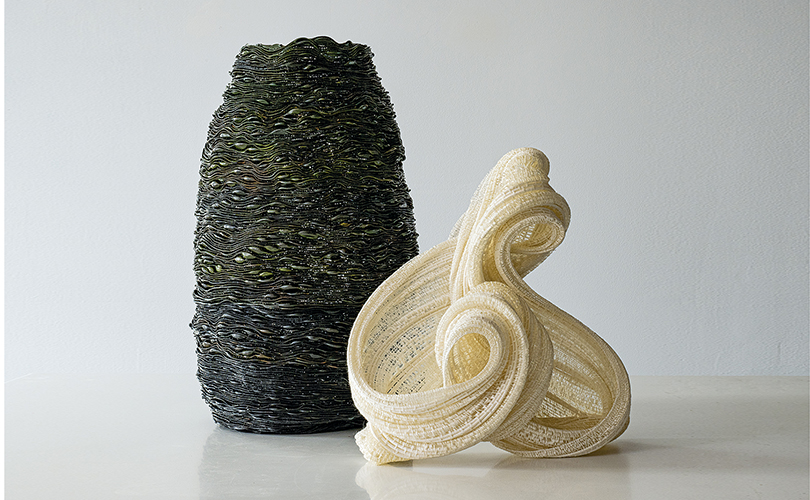
For our Spring exhibition, Crowdsourcing the Collective: a survey of textile and mixed media art (May 7 -15) browngrotta arts is delighted to introduce the work of two artists new to the gallery, Jennet Leenderste, Netherlands, US and Shoko Fukuda, Japan. Each of them creates sinuous and supple objects — Leenderste of seaweed and Fukuda of sisal, ramie and raffia.
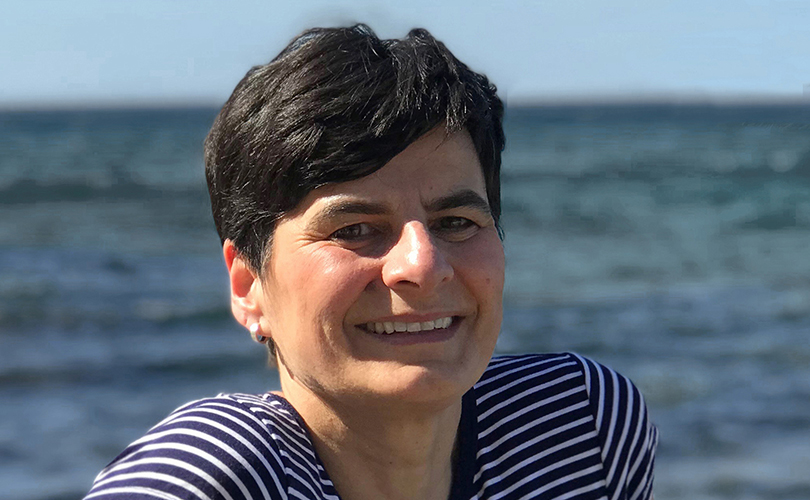
Jeannet Leenderste crafted with fabric as a child. She studied graphic design in the Netherlands and at 27 left for New York in search of an internship. After completing her degree cum laude, she moved to the Boston area and became an award-winning book designer. In recent years, has turned her focus again to textiles. Having grown up on the Dutch shore, her fiber work responds to the rugged coast of Maine, where she now lives and finds sculptural forms in the landscape and its creatures. As an immigrant, she says, her Dutch culture and heritage are always with her, while she continues to make this new environment her home. Exploring the concept of belonging, she develops work that feels at home in this marine environment. Adaptation and reflection are ongoing. Her fiber process brings these outer and inner worlds together.
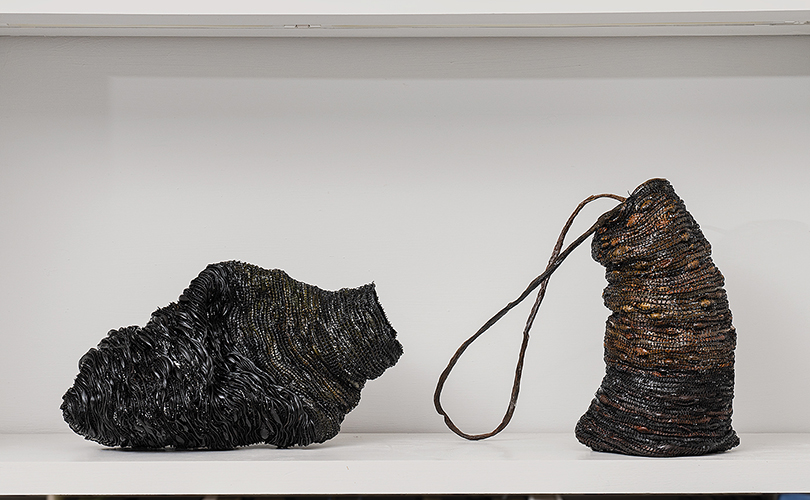
“My work grows from coastal impressions and material experimentation,” Leenderste explains. “It takes on a new life when moved out of the studio and placed back in its natural environment.” That feedback propels her process. “I feel a strong responsibility to consider my materials, and what my creative process will leave behind. She began foraging seaweed—in particular rockweed—to work with, and discovered the amazing benefits this natural resource provides. “Seaweed not only creates a habitat for countless species,” she says, “it sequesters carbon, and protects our beleaguered shoreline from erosion as our sea levels rise. Rockweed vessels show the beauty of this ancient algae, while drawing attention to its environmental value.” Several examples of Leenderste’s seaweed works will be featured in Crowdsourcing the Collective.
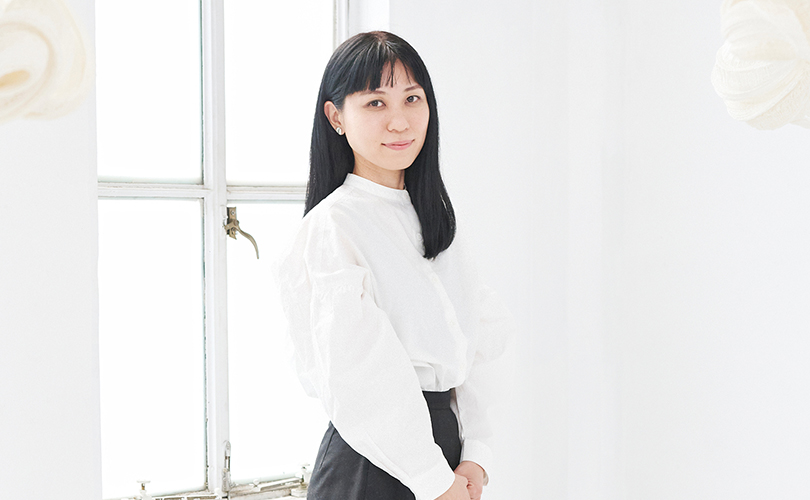
Shoko Fukuda is a basketmaker and Japanese artist who holds a Bachelor of Design from Kyoto University of Art and Design, and a Master’s degree from Osaka University of Art, where she focused on research in textile practice. She has exhibited her work internationally for the past 10 years. Shoko Fukuda currently works as an instructor at Kobe Design University in the Fashion Design department.
At browngrotta arts, we were recommended to Fukuda’s work by noted basketmaker Hisako Sekijima. “I encountered Sekijima’s artworks about 20 years ago,” Fukuda says. “Lines made with expressive plant materials were woven into an abstract and three-dimensional shapes. I had never seen such small artworks, like architectural structures before. I have been fascinated by the structural visibility and the various characteristics of the constructive form consisting, of regular lines ever since then.”
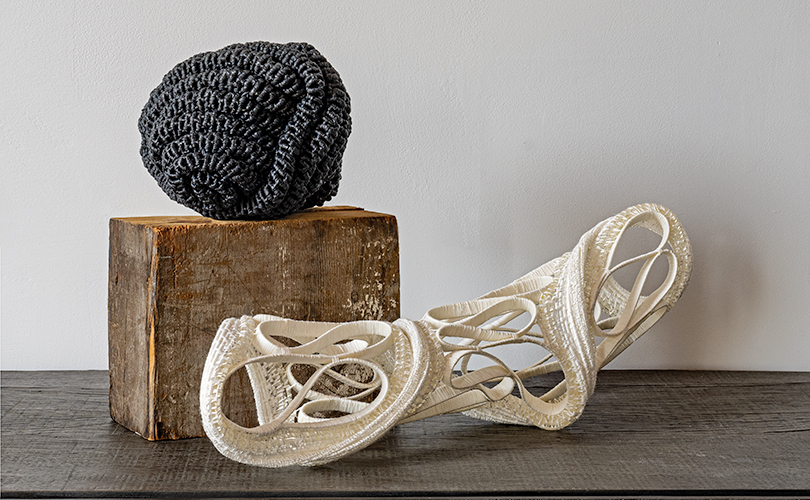
In Loop With Corners, Fukuda considered how to create a multifaceted form from a flat surface. By making corners, shapes are formed based on intentional decisions that lead to unexpected tortuous and twisted shapes. By weaving and fastening as if making a corner, a rotating shape was created. The movement of coiling creates a rhythm, and the lines being woven together leave organic traces in the air. In Vertical and Cylindrical helix is made of cylindrical spirals stacked like layers. They were woven from different directions — up and down, left and right — to form a single piece. The work has a dense structure, dyed black and shaped like a tightly closed shell.
Fukuda is interested in “distortion” as a characteristic of basket weaving. “As I coil the thread around the core and shape it while holding the layers together, I look for the cause of distortion in the nature of the material, the direction of work and the angle of layers to effectively incorporate these elements into my work. The elasticity and shape of the core significantly affect the weaving process, as the thread constantly holds back the force of the core trying to bounce back outward.” By selecting materials and methods for weaving with the natural distortion in mind, Fukuda saw the possibility of developing twists and turns. “I find it interesting to see my intentions and the laws of nature influencing each other to create forms.”
Fukuda’s work, like Leenderste’s, will be well represented at Crowdsourcing the Collective, our Spring 2022 exhibition. Join us at browngrotta arts May 7-15, 2022. Save your space here: https://www.eventbrite.com/e/crowdsourcing-the-collective-a-survey-of-textiles-and-mixed-media-art-tickets-292520014237
